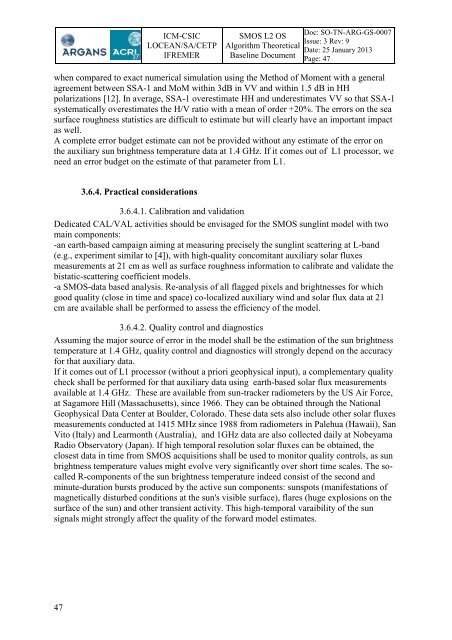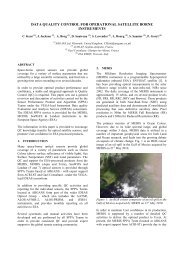SMOS L2 OS ATBD - ARGANS
SMOS L2 OS ATBD - ARGANS
SMOS L2 OS ATBD - ARGANS
Create successful ePaper yourself
Turn your PDF publications into a flip-book with our unique Google optimized e-Paper software.
47<br />
ICM-CSIC<br />
LOCEAN/SA/CETP<br />
IFREMER<br />
<strong>SM<strong>OS</strong></strong> <strong>L2</strong> <strong>OS</strong><br />
Algorithm Theoretical<br />
Baseline Document<br />
Doc: SO-TN-ARG-GS-0007<br />
Issue: 3 Rev: 9<br />
Date: 25 January 2013<br />
Page: 47<br />
when compared to exact numerical simulation using the Method of Moment with a general<br />
agreement between SSA-1 and MoM within 3dB in VV and within 1.5 dB in HH<br />
polarizations [12]. In average, SSA-1 overestimate HH and underestimates VV so that SSA-1<br />
systematically overestimates the H/V ratio with a mean of order +20%. The errors on the sea<br />
surface roughness statistics are difficult to estimate but will clearly have an important impact<br />
as well.<br />
A complete error budget estimate can not be provided without any estimate of the error on<br />
the auxiliary sun brightness temperature data at 1.4 GHz. If it comes out of L1 processor, we<br />
need an error budget on the estimate of that parameter from L1.<br />
3.6.4. Practical considerations<br />
3.6.4.1. Calibration and validation<br />
Dedicated CAL/VAL activities should be envisaged for the <strong>SM<strong>OS</strong></strong> sunglint model with two<br />
main components:<br />
-an earth-based campaign aiming at measuring precisely the sunglint scattering at L-band<br />
(e.g., experiment similar to [4]), with high-quality concomitant auxiliary solar fluxes<br />
measurements at 21 cm as well as surface roughness information to calibrate and validate the<br />
bistatic-scattering coefficient models.<br />
-a <strong>SM<strong>OS</strong></strong>-data based analysis. Re-analysis of all flagged pixels and brightnesses for which<br />
good quality (close in time and space) co-localized auxiliary wind and solar flux data at 21<br />
cm are available shall be performed to assess the efficiency of the model.<br />
3.6.4.2. Quality control and diagnostics<br />
Assuming the major source of error in the model shall be the estimation of the sun brightness<br />
temperature at 1.4 GHz, quality control and diagnostics will strongly depend on the accuracy<br />
for that auxiliary data.<br />
If it comes out of L1 processor (without a priori geophysical input), a complementary quality<br />
check shall be performed for that auxiliary data using earth-based solar flux measurements<br />
available at 1.4 GHz. These are available from sun-tracker radiometers by the US Air Force,<br />
at Sagamore Hill (Massachusetts), since 1966. They can be obtained through the National<br />
Geophysical Data Center at Boulder, Colorado. These data sets also include other solar fluxes<br />
measurements conducted at 1415 MHz since 1988 from radiometers in Palehua (Hawaii), San<br />
Vito (Italy) and Learmonth (Australia), and 1GHz data are also collected daily at Nobeyama<br />
Radio Observatory (Japan). If high temporal resolution solar fluxes can be obtained, the<br />
closest data in time from <strong>SM<strong>OS</strong></strong> acquisitions shall be used to monitor quality controls, as sun<br />
brightness temperature values might evolve very significantly over short time scales. The socalled<br />
R-components of the sun brightness temperature indeed consist of the second and<br />
minute-duration bursts produced by the active sun components: sunspots (manifestations of<br />
magnetically disturbed conditions at the sun's visible surface), flares (huge explosions on the<br />
surface of the sun) and other transient activity. This high-temporal varaibility of the sun<br />
signals might strongly affect the quality of the forward model estimates.



